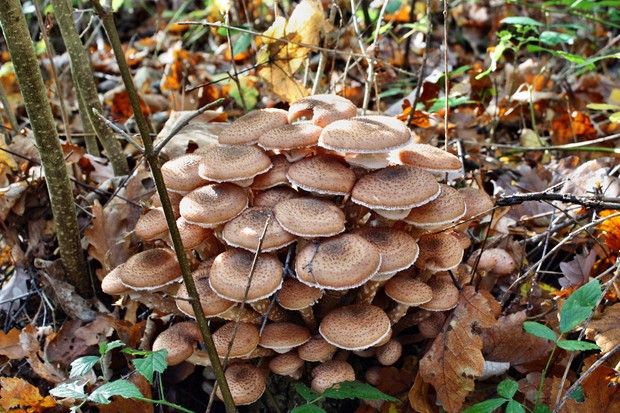

Honey fungus forms an underground network of bootlace-like threads called rhizomorphs, which attack the roots of susceptible plants – usually trees and shrubs.
A number of honey fungus (Armillaria) species are present in the UK, but it’s Armillaria mellea and Armillaria gallica that are usually encountered. The plants most commonly affected by honey fungus include lilac, viburnum, weigela, willow, cotoneaster, liquidambar, laburnum, rowan and forsythia, but this list is far from exhaustive. Annuals, biennials and herbaceous perennials are generally unaffected.
The first signs honey fungus might be present in your soil are a sparse crown, branch dieback, smaller than usual leaves, cracking and bleeding bark (particularly near soil level) and sometimes clumps of honey-coloured mushrooms. If you suspect honey fungus is present, have a look at the collar of the plant where the roots and stem meet, and look for signs of decay and white fungal material beneath the bark. Digging in the soil around affected plants will often reveal the dark, bootlace threads.
When honey fungus reaches a garden, the consequences can be dramatic, as it has the ability to kill old and majestic trees and shrubs, which can be a real issue for orchard owners.
While honey fungus will prevent you from growing many plants (at least for a few years), there are just as many, if not more, plants to replace them with. These include beautiful trees, shrubs and perennials.
Discover some of the many lovely plants resistant to honey fungus, below.
Japanese quince
[image id=”49543″ size=”landscape_thumbnail” title=”Chaenomeles japonica” alt=”Chaenomeles japonica. Sarah Cuttle” classes=””] Chaenomeles japonica. Sarah Cuttle
Not to be confused with the edible quince, Cydonia oblonga, which is a small tree, the Japanese quince (Chaenomeles japonica) is a wall shrub or hedging plant usually grown for its intense orange-red flowers in early spring. It’s best grown in a sunny or partly shaded spot in moist but well-drained soil.
Phlomis
[image id=”57903″ size=”landscape_thumbnail” title=”Hilliers Autumn (10th November 2014)” alt=”Phlomis seedheads in winter. Jason Ingram” classes=””] Phlomis seedheads in winter. Jason Ingram
Phlomis are among the best plants for winter interest, providing tiered seedheads and evergreen foliage. While in bloom, the flowers are a magnet for pollinating insects, particularly bumblebees. Some of the most popular phlomis to grow include Phlomis fruticosa, Phlomis russeliana, Phlomis longifolia and Phlomis tuberosa.
Lavender
[image id=”6283″ size=”landscape_thumbnail” title=”Lavender ‘Elizabeth’. Sarah Cuttle” alt=”Lavender ‘Elizabeth’. Sarah Cuttle” classes=””] Lavender ‘Elizabeth’. Sarah Cuttle
Like phlomis, lavender is a member of the mint family, Lamiaceae, which includes some species that seem to be generally resistant to honey fungus. It’s a fantastic sub-shrub that provides spikes of fragrant, nectar-rich flowers in summer. A good choice for poor soil.
Smoke bush
[image id=”84001″ size=”landscape_thumbnail” title=”Smoke bush (Cotinus coggyria). Jason Ingram” alt=”Smoke bush (Cotinus coggyria). Jason Ingram” classes=””] Smoke bush (Cotinus coggyria). Jason Ingram
Smoke bush (Cotinus coggyria) is a large shrub with airy pink summer flowers that resemble a cloud of smoke. What’s more, before the leaves fall in autumn, they turn vibrant shades of yellow, orange and red. Great for well-drained, fertile soil in full sun or partial shade.
Yew
[image id=”75981″ size=”landscape_thumbnail” title=”Yew (Taxus baccata). Sarah Cuttle” alt=”Yew (Taxus baccata). Sarah Cuttle” classes=””] Yew (Taxus baccata). Sarah Cuttle
Fortunately, Yew (Taxus baccata) is rarely affected by honey fungus. This large conifer works well as an evergreen hedge or a backdrop to shrubs and perennials. It is ideal for clipping and can be used for topiary.
Honeysuckle
[image id=”77584″ size=”landscape_thumbnail” title=”Honeysuckle (Lonicera periclymenum). Jason Ingram” alt=”Honeysuckle (Lonicera periclymenum). Jason Ingram” classes=””] Honeysuckle (Lonicera periclymenum). Jason Ingram
The honeysuckle or Caprifoliaceae family includes many different types of honeysuckle. Climbing honeysuckles are ideal to cover walls and fences with masses of sweetly-scented flowers in summer. Evergreen shrubby honeysuckles make great low hedges and winter-flowering honeysuckles have among the best scented flowers for the colder months.
Myrtle
[image id=”212702″ size=”landscape_thumbnail” title=”bCommon myrtle. Jason Ingram” alt=”Common myrtle. Jason Ingram” classes=””] Common myrtle. Jason Ingram
The common myrtle, Myrtus communis, is an evergreen shrub or small tree bearing fragrant white flowers in late summer. Once established, it has good drought tolerance. There are compact varieties suitable for container growing and also a variegated myrtle, Myrtus communis ‘Variegata’.
Salvias
[image id=”23463″ size=”landscape_thumbnail” title=”Salvia ‘Rose Queen'” alt=”Salvia ‘Rose Queen’. Torie Chugg” classes=””] Salvia ‘Rose Queen’. Torie Chugg
Salvias have mercifully proven to be resistant to honey fungus. There are lots of beautiful types to grow, including herbaceous and shrubby types.
